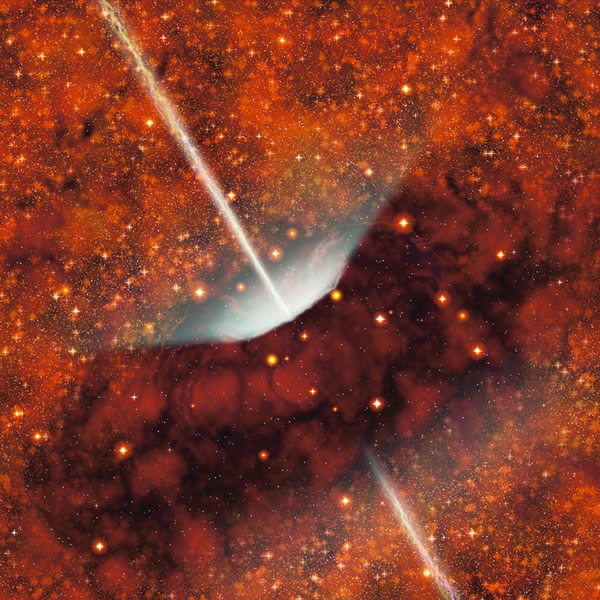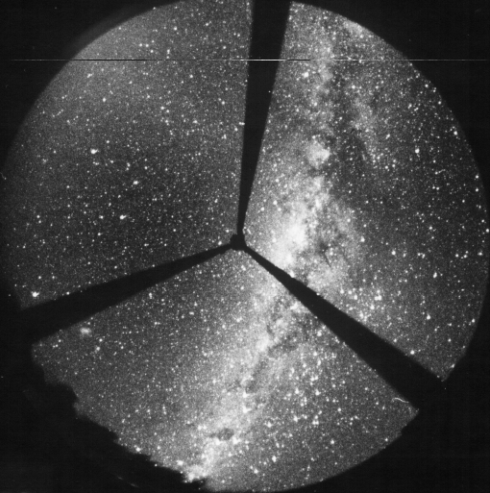
We have been learning about the various kinds of stars, and star clusters that inhabit our galaxy. Now lets talk about our galaxy, the Milky Way. In a very dark location, during most of the year, there is a faint band of light that bisects the night time sky. Because it spans such a large angular size, it is hard to photograph even though it is easy to see. Here is a photograph taken by looking at the reflection of the night sky off a spherical mirror (note the struts that support the camera):

Here is a "fish-eye lens" view of the southern hemisphere sky showing a bright comet (Hyakutake), the fish-eye lens distorts the view, but it is still spectacular:
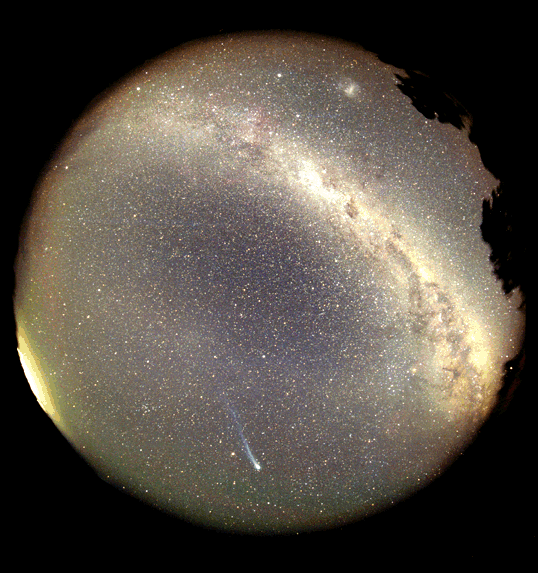
Close inspection of these pictures shows that the Milky Way does not have a uniform thickness, and is very patchy. In the wintertime sky, the Milky Way is a thin band of light, and is quite faint. In the Summer, however, the Milky Way is brighter, and gets very thick in width towards the constellation of Sagittarius (which is the bright, lower right hand part in the fish-eye view). Note how patchy the Milky Way appears to be---there are dark lanes, or rifts, as well as isolated dark regions. If we photograph the Milky Way throughout the year and construct a composite that represents all 360 degrees of the circle, we get an image that looks like this:
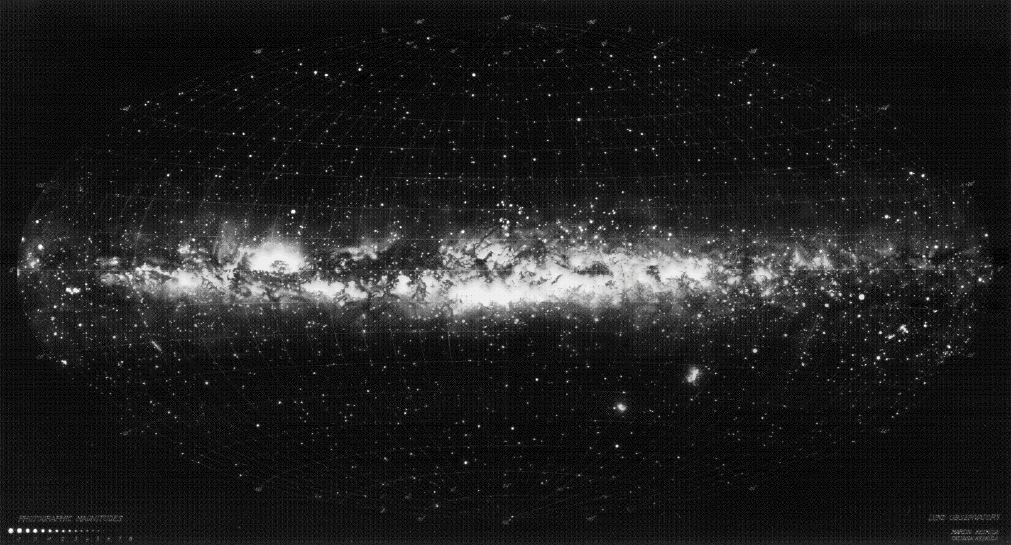
Note that this photograph actually should be printed out and the two ends connected to make a full circle, as the Milky Way appears to be a complete circle around us (this type of map "projection", transforming a sphere into a flat, two dimensional object is also used for world maps). What is the Milky Way, and why does it appear the way it does? This was a puzzle for many years until Galileo pointed his telescope at this faint band of light and found out that it was composed of stars---in fact millions and millions of individual stars. Each by themselves is too faint to see with the naked eye, but when in the company of millions of other faint stars, merge to produce a faint, continous band of glowing light. So, by 1610 or so, we finally discovered that the Milky Way is a band of faint stars. How can we explain its apparent structure? The first model to attempt to explain the Milky Way was made by Englishman Thomas Wright in 1750. He thought that the stars that formed the Milky Way were arranged in a thick ring, and that our solar system was within this ring:
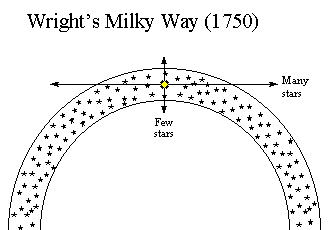
If we look into the ring we see many stars, but if we look perpendicular to the ring, we see few stars. There are some obvious flaws with this model, but it was the first serious attempt to explain what we see. About the same time as Wright proposed his ring model, the philospher Immanuel Kant (1724 - 1804) proposed that the Milky Way was actually a disk, and we were imbedded in the disk. It was left to William Herschel (1738 - 1822) to laboriously count the stars in different directions to figure out which of these models worked best. His results are shown here:

This is a vertical slice through Herschel's model, and the Sun is the large star near the center. Note that to the right, there is a dark lane which has very few stars. This is the same feature shown in the fish-eye view, as that dark lane is towards the direction of Sagittarius. In three dimensions, Herschel's model resembled the disk idea proposed by Immanuel Kant, though it was somewhat lopsided. So what is the cause of these lanes, and dark patches? Dust, of course. If we photograph the Milky Way using infrared light that penetrates right through dust, we get a different view:
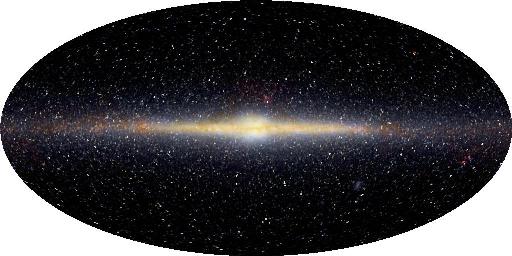
Again, this represents a 360o view of the sky, so, you have to imagine wrapping the ends around so they touch, and that you are viewing the picture from inside the cylindrical photograph. In infrared light, the dust clouds are almost transparent (though you still see hints of them as the yellowish areas). Now we can see the true shape of the Milky Way--it is a disk-like object that is thicker in the middle, and gets thinner at the edges. The thickest part of the galaxy is in the direction of Sagittarius, and this is where there are more dust clouds that obscure the light of distant stars causing Herschel's dark finger that lacks stars.
How big is this disk, and what is its structure? This is a very hard question to answer, and was one of the main issues that was being argued about 100 years ago. Imagine standing in the middle of a large forest and then being asked to determine how far the forest extends in each direction! Even in a small grove of trees, you cannot see very far because your line-of-sight eventually intercepts the trunk/branches/leaves of another tree:

"Hard to see the forest for the trees". The arguments about the size and nature of the Milky Way galaxy culminated in something called the "Great Debate" (in 1920) by two astronomers named Curtis and Shapley. Curtis argued that the Milky Way and the "spiral nebulae" were "Island Universes"--bound collections of stars, gas and dust. While Shapley argued that the spiral nebulae were in the Milky Way, and that Milky Way was the Universe. Shapley also believed that the Milky Way was very large, and that we were not in the center. Shapley was wrong about the Island Universes, but was correct about the rest. In addition, the techniques Shapely pioneered allowed us to finally understand the size and shape of the Milky Way (which Curtis thought was much smaller than Shapley, and believed that we were at the center). It has taken a long time to figure out the shape and size of our galaxy, but we have done so. In figure 19.1 the size and shape is shown, along with various features of the galaxy:
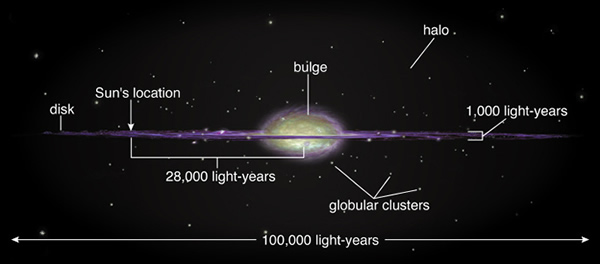
An enormous amount of information was used to construct this view of our galaxy, including information gathered about other galaxies that seem to have the same structure as ours. For example, we soon found out that all of the stars, star clusters, and molecular clouds in the Milky Way are actually moving! In fact, they are all moving in roughly the same direction--the Milky Way is a rotating disk of stars and gas. The center of this rotation (the point about which all of the stars seem to be moving) is located in the constellation of Sagittarius at a distance of 28,000 light years. Remember that a light year is the distance light travels in a year (see the notes for Class #01 ):
one light year = speed of light x number of seconds in a year
or
A light year is thus about 10 trillion kilometers. The center of our galaxy is 28,000 light years from the Sun. The entire disk of the Milky Way has a diameter of approximately 100,000 ly. Note, however, that the disk of stars near the Sun is actually quite thin: about 1,000 ly thick. The thickest part of the Milky Way is called the "bulge". The bulge is a roughly spherical distribution of stars that has a radius of about 5,000 ly surrounding the center of the Milky Way. It is common for astronomers to switch units at this stage. Remember the parsec ("pc")? It was 3.26 ly. To talk about distances within the Milky Way galaxy, it is more useful to talk about them in parsecs, and kiloparsecs (kpc). A kiloparsec is 1,000 parsecs, or 3,260 ly. Using kpc, the Sun is 8.5 kpc from the center, and the Milky Way is 30,000 kpc across (we will soon use the unit Mega-parsec, so get ready!). If we actually plot the locations of all of the young clusters of stars, we find that they actually trace-out the arms of a pin-wheel like structure:
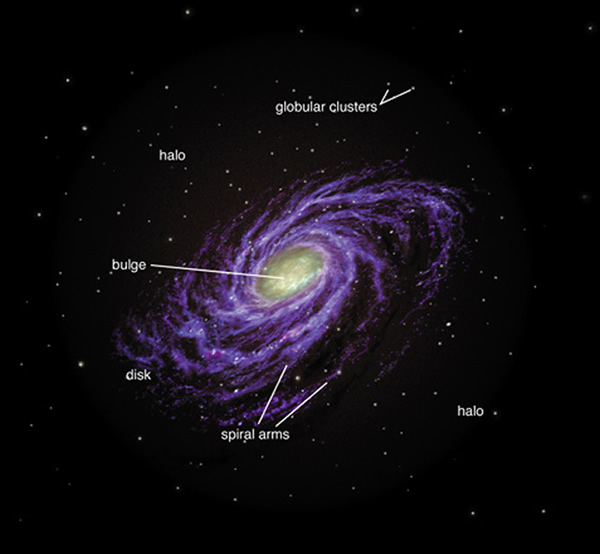
These young hot stars trace out a spiral pattern, and these young stars are located in the "spiral arms" of the Milky Way. While the stars in the spiral arms are generally young (all of the star forming regions are found in the arms and disk), the stars in the bulge of the Milky Way are generally old, red giants. If we could fly high above the disk of the Milky Way, we would expect it to look like this:
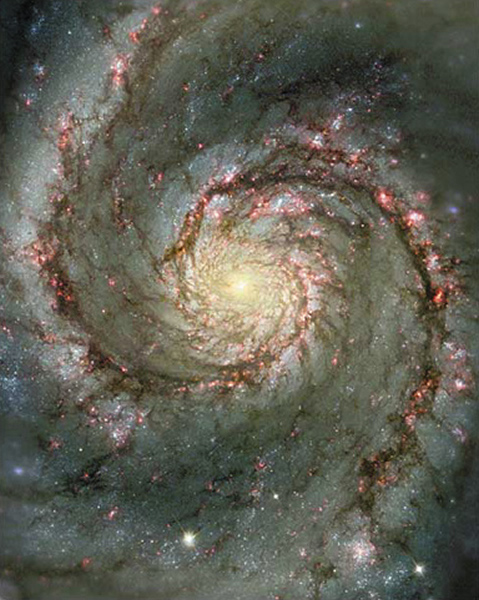
Note the pinkish areas--young star formation regions---are mostly confined to the spiral arms There are no star forming regions in the bulge, except in the parts where the disk of the galaxy and the bulge are coincident (that is where they blend together). Note how most of the dust is confined to the spiral arms---where the giant molecular clouds are. In these regions it is cold enough to keep the dust from evaporating. In the Milky Way (and other "spiral" galaxies), there is something called a "density wave", not unlike a sound wave. It is essentially stationary, but as the stars and gas rotate around the galaxy, they bunch-up as they hit the wave:
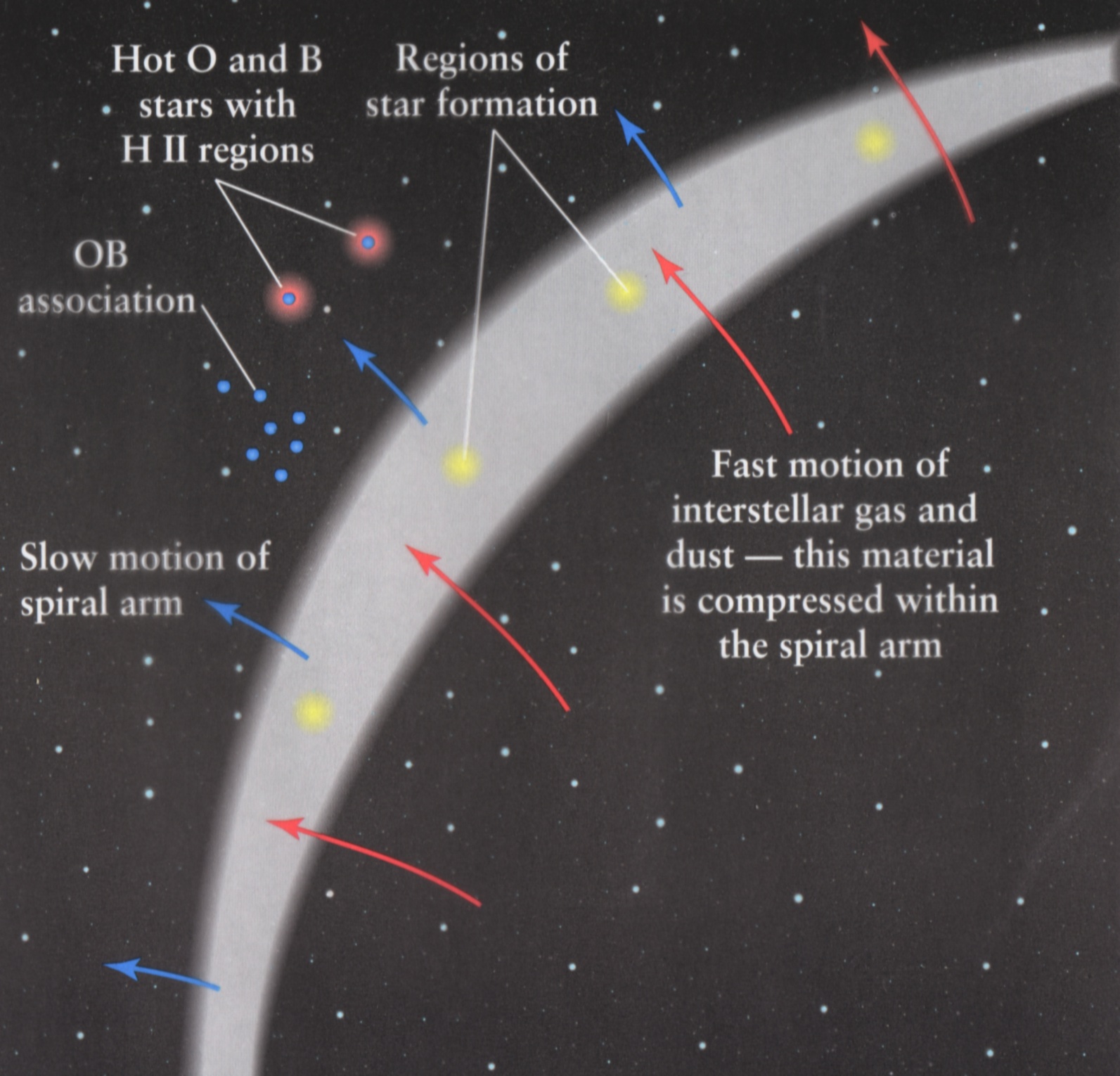
Because our galaxy is spinning, and the stars closer to the center are moving more rapidly than those further out, you get a spiral pattern:

The bulge of our galaxy is older than the disk. Surrounding the galaxy is a low density region called the "halo". There are stars in the halo, but not very many of them, and the ones we find there appear to be very old. Also in the halo are the globular clusters. The globular clusters orbit around the center of our galaxy, and in a way, are like the comets in the Oort cloud orbiting around the Sun:
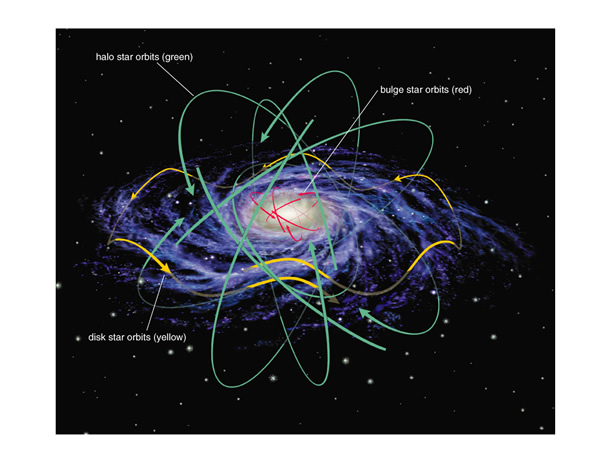
As we noted last class, the globular clusters are also composed of old stars, even older than the bulge stars.
This gives us one idea of how the Milky Way formed---a view that is almost identical to our model for how the solar system formed: a large spherical cloud of gas and dust collapsed:
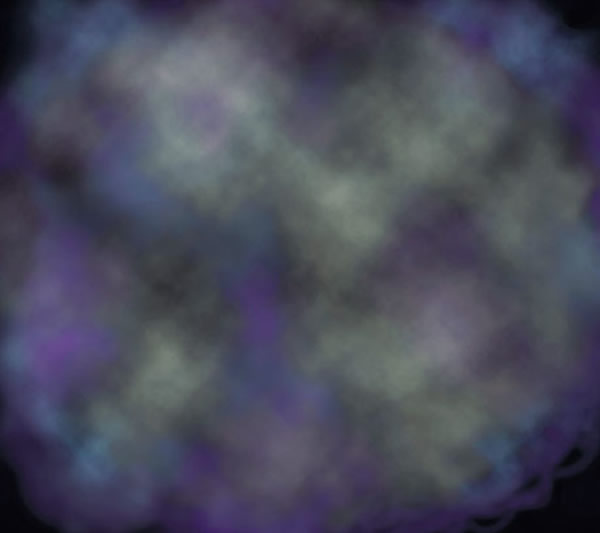
The first stars formed out near the edges of this clouds of gas when it was still spherical, and these stars formed the halo. Some of the regions in the cloud of gas were dense enough to form the globular clusters:

As the "proto-galactic" cloud collapses, the small rotation of the cloud is amplified, and this flattens out the cloud forming a disk:
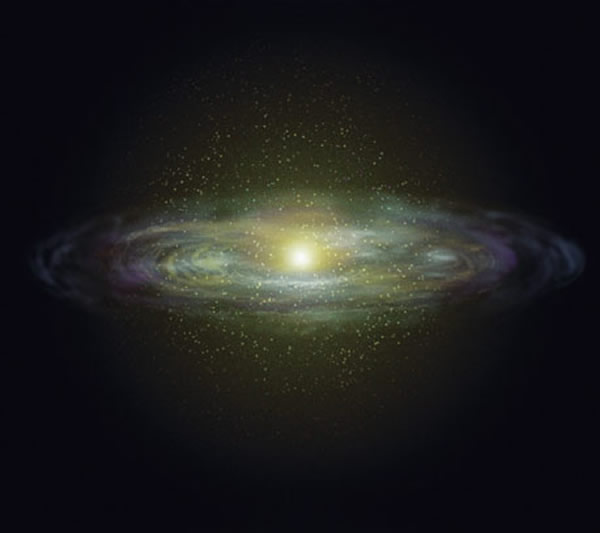
The density was highest in the central regions (like the region surrounding the proto-Sun), so stars formed there before the stars in the disk (which are like the planets), and these stars are older, and there are more red giants there making the bulge have a yellower color than the spiral arms which are full of hot blue stars:
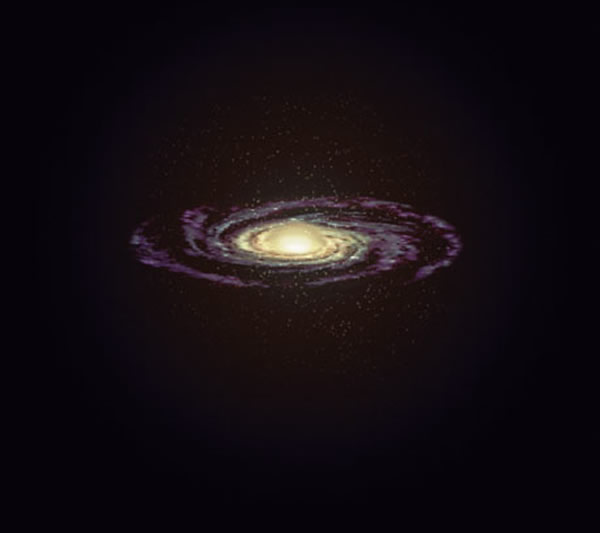
The big difference between the formation of the Sun and solar system and the Milky Way galaxy is one of scale: the gas cloud that formed the Milky Way contained hundreds of billions of solar masses! We know this because we can estimate how many stars there are in our galaxy and that number is between 100 billion and 200 billion.
We believe that the cloud of gas from which the Milky Way formed was intially composed of only hydrogen and helium---no dust or heavier elements. We find that the oldest stars (those in the halo) support this idea, as they seem to have very few elements besides hydrogen and helium. It was the first supernovae explosions that "seeded" the gas clouds with elements like iron, carbon, oxygen, etc. The cycle is shown in Figure 19.2. First we have stars form out of molecular clouds. These stars fuse hydrogen to helium on the main sequence, and then start making carbon and heavier elements as they enter the red giant and supergiant phases. Much of the carbon, oxygen and nitrogen are formed in the atmospheres of red giants, and these elements are returned to the galaxy through the winds of these stars (and during the planetary nebula phases). When massive stars explode, they send the heavier elements out into the galaxy. These elements are then mixed into the molecular clouds, and the next generation of stars has more heavy elements. The youngest stars forming now have more of these elements than the preceding generations. This process is called "chemical enrichment". Without this process, there would be no life on Earth, or even an Earth!
Is there anything special about the center of the Milky Way? Unfortunately, we cannot see the center of the Milky Way using visible light---there is just too much dust in the way, and we have to use infrared and radio waves to investigate what is going on there (see Figure 19.23 and 19.24):
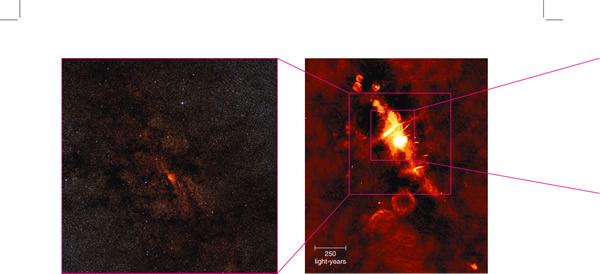
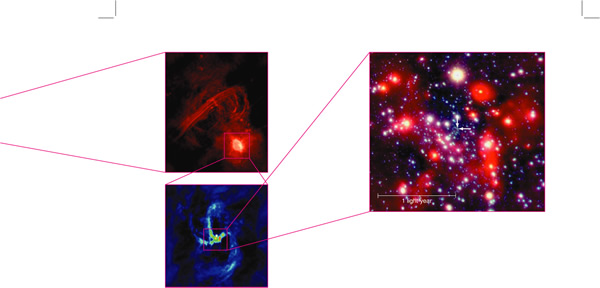
When we use these other forms of electromagnetic radiation to examine the center of the galaxy we find that it is a very unusual place. There is a very strong radio source there, and a lot of hot gas that is moving with high speeds in all directions, and swirling around the very center. Something violent seems to have happened there, or is still happening there. When we measure the motions of the stars there we find that they are moving at very high speed in orbits around a small, massive central object:
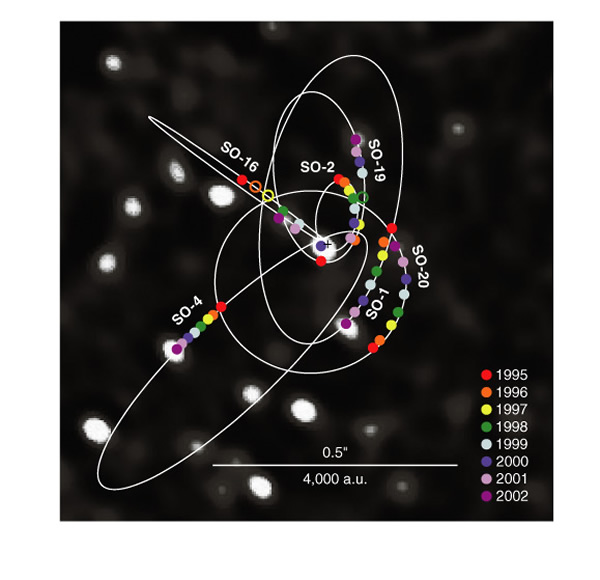
(Click here for movie showing this motion.) But this object does not appear to emit very much light. A black hole! But unlike the black holes created by the supernovae of massive stars---which have masses of ten times that of the Sun---this black hole appears to have a mass of 10 million solar masses! A "super massive" black hole. Why is it there? The density of stars is very high at the center of the galaxy, and when the massive stars explode forming stellar-sized black holes, there are a large number of black holes orbiting around the center. These black holes could merge to form larger and larger black holes---and then they can further grow in size by eating other stars and gas. We will find that many galaxies like ours have super massive black holes at their centers. We believe that the black hole at the center of our galaxy was once active (and may some day become active again). When the black hole is active, a disk of material--an accretion disk like those in interacting binaries---forms around the black hole, and a jet of material exits along the poles:
